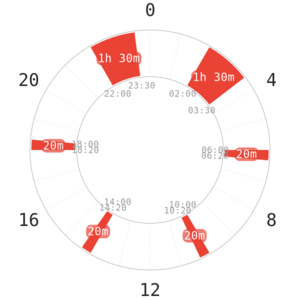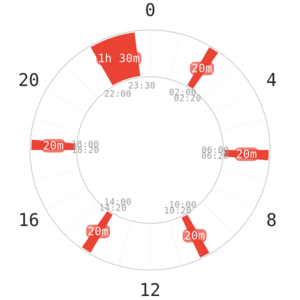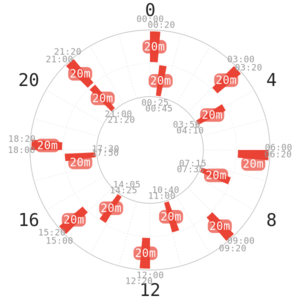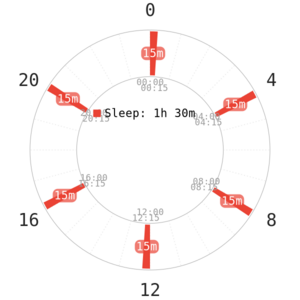Uberman
| Uberman 6 | |
|---|---|
| chart link
Legend
| |
| Total sleep | 2 hours |
| Proposed by | Puredoxyk |
| Difficulty | Extremely difficult |
| Specification | 6 naps equidistantly placed throughout the day |
Uberman is the most widely known form of polyphasic sleep, with its appeal being the large amount of extra wake time it provides. For this reason, it is also one of the most widely attempted schedules by many first-time polyphasers. However, the adaptation success for this schedule is rare, with most attempts at the schedule ending in failure, since it does not meet the minimum sleep need for the majority of people.
Origins
A variant of this schedule, with 15-minute naps, was mentioned in Claudio Stampi's book Why We Nap, and was attributed to Leonardo da Vinci. As documented in the book, Italian artist Giancarlo Sbragia adapted to this schedule at the end of the 1950s, and stayed on it for 6 months.
The current iteration of the schedule is created and named Marie Staver (Puredoxyk) and her buddy Psuke Briah in 1999, drawing inspiration from a TIME article about Buckminster Fuller’s Dymaxion sleep. It was first revealed in a post on everything2.com in 2000. It was further elaborated on in her book Ubersleep.[1]
Puredoxyk stayed on the schedule for 6 months in 2000 and she was not able to re-adapt to it later.
Steve Pavlina adapted to the schedule in 2005, and stayed on it for 5 months, and has not done it again ever since.
Mechanism
Like other nap only schedules, Uberman requires extreme rigidity and sleep compression, which makes it one of the toughest sleep schedules.
Adaptation
Adapting to Uberman is extremely difficult. While some people may claim that there is an easier method, that is simply not the case. Any methods of adapting to this schedule involves prolonged, intense sleep deprivation which is necessary to produce the level of sleep compression required.
Without previous napping experience, naps will mostly contain light sleep or traces of SWS. As the REM need is not being fulfilled, REM pressure quickly builds up to high levels, causing a REM rebound. This usually happens around day 3-5. This will appear to suddenly alleviate the sleep deprivation, making people prone to overconfidence about the adaptation. After this, naps mostly contain REM, and SWS pressure starts to build up. SWS rebound usually occurs on day 7-8 and it is the hardest part of the adaptation where most people oversleep and fail their schedules. After avoiding this first crash, subsequent crashes once every 2-3 days also needs to be avoided. REM and SWS pressure gradually reaches an equilibrium and the schedule is finally stabilized. This can take weeks and some may need up to 6 weeks on the schedule.
Human supervision
It is important to realize that willpower alone is not enough for adapting to this schedule. With SWS deprivation, willpower simply will not help you. People have reported unconsciously disabling or ignoring electronic devices and performing other actions necessary to go back to sleep, with no recall whatsoever afterwards. People have slept through noise-based alarms, flashing lights, loud fans, and repeated maximum-voltage shocks from a Pavlok. It is therefore very useful, if not necessary, to have constant human supervision to make sure you are awake when you are supposed to be. To date, most people, who adapted to this schedule, had the help of another human. Puredoxyk was woken up by Psuke and Youtuber Aeia was woken up by her twin sister during her adaptation. Without the help of other people, it is very unlikely that you would ever adapt to this schedule.
Delaying the SWS rebound
It is possible to delay the SWS rebound by a few days by adding extra naps in the night for extra SWS gain during the first days of adaptation. Steve Pavlina used this method to delay his SWS rebound until around day 12. It is not generally a good idea though, since the rebound will eventually happen and doing this just drags out the adaptation process by a few days and overcoming the SWS rebound is essential to Uberman adaptation.
Gradual adaptation via rhythmic preservation


Ideas have also been proposed about the use of rhythmic preservation to gradually transition to Uberman. E5 and DC4 are the possible transition schedules to Uberman with sleeps scheduled to start at the same time as the goal Uberman schedule. It might train the body rhythm to align the waves of tiredness with Uberman naps. This could reduce the transition difficulty somewhat. Still, intense compression and repartitioning will be required at the each transition, especially at the final jump to Uberman. With two transitions, the adaptation would stretch out to several months and the overall difficulty is only slightly reduced. Overall, this may not be worth the extra time required.
Exaptation
Naptation, in which naps are taken every 2 hours instead of 4 on Uberman, has been used to quickly learn napping. This may allow an easier start, as the ability to gain REM in naps would be present from the start.
Difficulty
Both Steve Pavlina’s blogs and Puredoxyk’s book Ubersleep understated the schedule’s difficulty. Puredoxyk adapted to the schedule in times of extreme stress at university, and was unable to adapt to it again afterwards. Nevertheless, people tend to overestimate their chances of succeeding. There has been no detailed accounts of someone adapting to the schedule in more recent times. However, it is also worth noting that the Discord community has been almost universally discouraging Uberman attempts, and few serious attempts have been made in the past few years, which may have contributed to the lack of success.
You may see many logs of people attempting this schedule, but most of them ends in just a few days, presumably because the author overslept and gave up. Those failures are often used to discredit polyphasic sleep altogether, without ever considering more reasonable schedules.
Lifestyle Considerations
Over the years, through anecdotes of adapted sleepers, the downsides of Uberman has been gradually discovered. These may include:
- little for exercising (especially with gaining muscle)[2]
- tendency to gain weight[3]
- near total inflexibility of sleep, even after adaptation [1]
- 3h40m wake gap between each nap is usually too short for real-world commitments
Steve Pavlina worked from home when adapting to Uberman, and Puredoxyk also had a flexible job during her university years when she adapted to the schedule.
The harsh adaptation is extremely sensitive to skipping naps. As claimed by Puredoxyk in Ubersleep, just skipping one nap causes intense sleep deprivation, similar to when one skips a few nights of monophasic sleep in a row. Even after adaptation, the risk of oversleeping remains, and alarms may have to be maintained indefinitely.
As with other nap-only schedules, Uberman impedes the clearance of brain waste via the glymphatic system, because the longest continuous sleep block is only 20 minutes. It is therefore currently unknown as to how this schedule can be maintained, especially by those with average SWS needs.
Variants
Extra naps

Having one or two extra naps might make Uberman more sustainable for people since 2h is far below the minimum requirements of an average person, and consequently lower adaptation difficulty. However, these variants are even less realistic socially since 3h5m and 2h40m wake blocks are simply too short for doing anything. No one is known to have adapted to these variants of Uberman.
Shorter naps

This variant is said to have been done by Leonardo Da Vinci. However, there is little evidence for this. Claudio Stampi, a polyphasic sleep researcher, has disputed that Da Vinci followed this Uberman variant. Unfortunately, as it stands, there is not enough evidence today to confirm this popular internet myth.
Why We Nap documented Italian artist Giancarlo Sbragia's anecdotal adaptation to this variant of the schedule. This sleeper, in his journal, recounted his adaptation to this Uberman variant that totaled only 1h30m of sleep each day, mirroring the alleged Uberman variant of Da Vinci. It took him 25 days to adapt, and he remained on it for a couple months. He eventually ran out of things to do, as he claimed, and returned to monophasic sleep.
Denser naps at night

In this variation of Uberman more naps are placed during the night since sleep pressure is generally higher during nighttime and it would also be easier to schedule one’s life around longer daytime gaps. However, it is very difficult to stay awake for long periods of time on Uberman and this is likely even harder than regular Uberman. No one has been known to have adapted to this, either.
Research
Up to date, there has only been one official study on Uberman sleep, which is motivated by its existence and creation from Puredoxyk and its widespread practice over the decades. In 2013, the research focused on the endocrine and cognitive effects of Uberman sleep. This study[4] lasted for 5 weeks. Unfortunately, according to the authors of the paper, no more information is available from the experiment beyond the abstract.
This study sheds some light on the vision of a long-term Uberman lifestyle as well as its implications on overall well-being of polyphasic sleepers. It is remarkable that most of the subjects quit the experiment because of social life rather than the grueling adaptation by week 3, and one subject did last until the end of the 5-week experiment. These participants were monitored 24h a day, and were woken up when needed to be.
None of these subjects were habitual nappers or sleep mutants, the remaining subject might have adapted to Uberman after 5 weeks, as his cognitive performance and cortisol secretion pattern became stable. At the same time, 5 weeks may not be enough for a successful Uberman adaptation. Even if it was a success, it took laboratory-controlled environment to get this far on Uberman - a regular adaptation with multiple alarms, no human assistance as mentioned before, will most definitely lead to failure.
Despite the seemingly positive news on this hostile schedule, it was discovered that growth hormone (GH) was greatly suppressed. Instead of being secreted in one large peak during monophasic sleep, it was now secreted after 6 naps in much smaller peaks. This might be because SWS was interrupted. This also explains why physical training would be ineffective on Uberman.
References
- ↑ 1.0 1.1 Puredoxyk (2013). Ubersleep: Nap-Based Sleep Schedules and the Polyphasic Lifestyle.
- ↑ DontPanic (17 Feb 2017). "Message". Polyphasic Sleeping Discord Server. Retrieved 2020-12-19.
- ↑ Hu, Aya (4 July 2010). "Giving up Polyphasic Sleep". YouTube.
- ↑ Rak M, Kunath N, Breitenstein B, Pawlowski M, Steiger A, Dresler M (2013). "Endocrine and cognitive effects of a radically polyphasic sleep schedule". Pharmacopsychiatry. 46 (6). doi:10.1055/s-0033-1353314.
